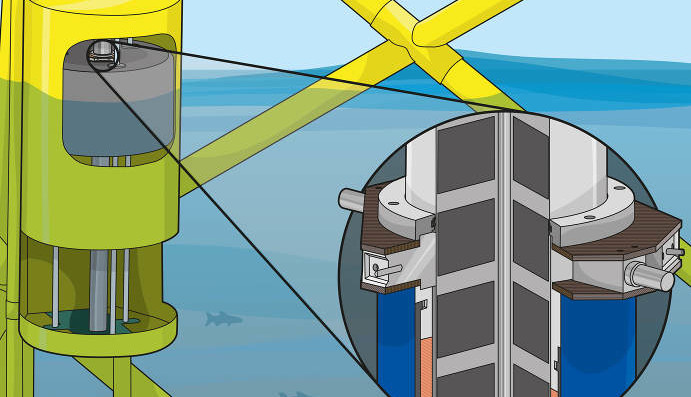Cambridge men & power from the seas
August 22, 2016
on
on

Trident Energy and 42 Technology, both Cambridge based, have jointly produced a Mark-2 version of the PowerPod generator, which converts wave energy to electricity using magnets sliding back and forth through coils. The new release is claimed to generate 50% more electrical power on each linear displacement from the same physical size.
To widen the range of installations in which PowerPod can work, the magnetic stack has been re-configured for the new version to allow the generator to operate horizontally. Seal design has also been improved for better operation at sea, and more robust bearings increase reliability and reduce maintenance.
Four-quadrant control of power conversion (building on work at the University of Cambridge) allows the mechanical damping and spring coefficients of the generator to be modified to match energy demand to wave conditions. Improvements for the Mk. 2 add real-time control capability to the power converter.
Assisting Trident Energy and 42 Technology with the new product were the University of Warwick (control system implementation); West Coast Wave Initiative/University of Victoria (hydrodynamic modelling and control systems); Technology from Ideas (stress-strain tailored motion end-stops); Energy Technology Centre (wave simulating test bed); Sgurr Energy (project management. Just mentioning these names to widen your field in case you’re looking for a job in Energy Management — good luck!
To widen the range of installations in which PowerPod can work, the magnetic stack has been re-configured for the new version to allow the generator to operate horizontally. Seal design has also been improved for better operation at sea, and more robust bearings increase reliability and reduce maintenance.
Four-quadrant control of power conversion (building on work at the University of Cambridge) allows the mechanical damping and spring coefficients of the generator to be modified to match energy demand to wave conditions. Improvements for the Mk. 2 add real-time control capability to the power converter.
Assisting Trident Energy and 42 Technology with the new product were the University of Warwick (control system implementation); West Coast Wave Initiative/University of Victoria (hydrodynamic modelling and control systems); Technology from Ideas (stress-strain tailored motion end-stops); Energy Technology Centre (wave simulating test bed); Sgurr Energy (project management. Just mentioning these names to widen your field in case you’re looking for a job in Energy Management — good luck!
Read full article
Hide full article


Discussion (0 comments)